Module 4
1. Module 4
1.6. Page 4
Module 4—Magnetic and Electric Fields in Nature and Technology
 Read
Read
There are many devices that use electromagnets. Some common ones are explained in the document “Applications of the Electromagnet.” More information on hand rules and electromagnets can be found on pages 587–589 of the textbook.
 Module 4: Lesson 1 Assignment
Module 4: Lesson 1 Assignment
Remember to submit the answers to A 1, A 2, A 3, A 4, and A 5 to your teacher as part of your Module 4: Lesson 1 Assignment.
A 1. Using the diagrams below, indicate the direction of the magnetic field associated with the wire when the current is flowing in the direction indicated. (Electron current flows from negative to positive.)
a.
![]()
b.
![]()
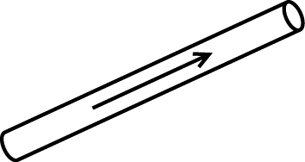
d.
![]()
e.
![]()
A 2. Using the diagrams below, indicate the direction of electron flow if the associated magnetic field is in the direction indicated.
a.

b.
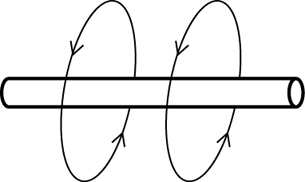
c.
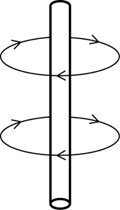
A 3. Given the diagram below, indicate whether a dot or an “x” should be placed in each circle. (Note that current is the direction of the electrons, e- flow.)
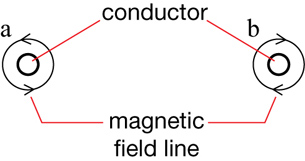
A 4. Given the diagrams below, indicate the path of the current (e- flow) that produces magnetic poles as indicated.
a.

b.

c.

A 5. Given the diagrams below, indicate the direction of the magnetic field created by the current (e- flow) flowing through the solenoid.
a.
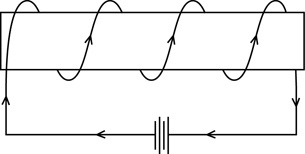
b.
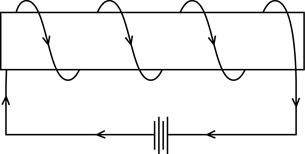
c.
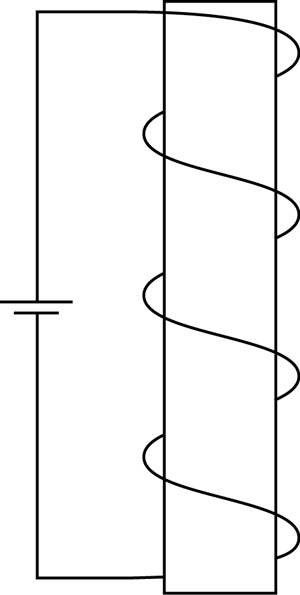
d.

e.
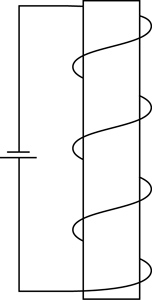
Domain Theory
If magnetic fields are produced by moving charges, how is it possible to understand the magnetic field produced by a permanent bar magnet? Furthermore, how can it explain why heating a piece of iron will cause it to not be attracted to a magnet, but the attractive force will return when the piece of iron is cooled? Revisit the first Watch and Listen activity of this lesson, if needed, to see the demonstration of how heating and cooling destroys and restores the magnetic properties of iron.
ferromagnetic material: a metal with adjacent atoms having electron movement that, taken together, form a small region with an intense magnetic field
Examples include iron, nickel and cobalt.
domain: the region of a material in which the magnetic fields of most of the atoms are aligned
As you learned in previous lessons, the moving charges associated with matter are the electrons. In some atoms the electron movement generates a very small magnetic field. Ferromagnetic material—such as iron, nickel, and cobalt—has many adjacent atoms with electron movement that, taken together, form a small region with an intense magnetic field.
Each region, about 1 mm across, contains billions of atoms and is referred to as a domain. Within the domain, the tiny magnetic field associated with the movement of each electron is additive, producing a significant magnetic field. When all the domains of a bar magnet, for example, align together, it is said to be magnetized. When the domains are erratically arranged they cancel one another out and the overall magnetic properties no longer exist.


The domain model helps explain the effect of heat on the magnetic properties of a permanent iron magnet. When heated, the atoms composing the domains become agitated and the electron movement changes, effectively destroying the alignment of the domains, so the iron loses its magnetic field. When the iron cools, the unaligned domains are locked in place and the magnet is a regular piece of iron.
To change the piece of iron back into a permanent magnet it must be heated, which frees the domains to change alignment, placed in a strong external magnetic field and cooled. The external magnetic field causes the excited domains to align and they are locked into position as the iron cools. The domains of the piece of iron are aligned again and it becomes a magnet again.
The domain theory also explains why non-magnetized materials, such as iron, can become magnetized in the presence of another magnet. The magnetic field lines emanating from a permanent magnet can cause the alignment of some of the domains that exist in other metals, thereby giving them magnetic properties too. This explains why metal containing iron or nickel are attracted to permanent magnets. The external magnetic field causes an alignment of some of the domains in the iron or nickel, giving it weak magnetic properties, which can then interact with the external magnetic field that caused the alignment. When the magnet is moved away from the iron, the domains quickly lose their alignment and the iron is non-magnetic again.
 Try This
Try This
TR 3. Complete “Check and Reflect” questions 7–13 on page 592 of the textbook.
For question 10, make sure you think about two things in each case: (1) what is the source of the field, and (2) what is the test object?
 Discuss
Discuss
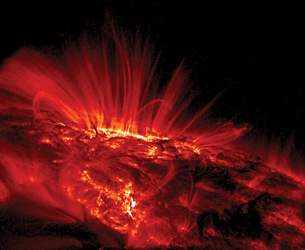
NASA/LMSAL
The Sun has a very complex magnetic field, caused by its rotation and the moving charge within its core. In the photograph to the right, erupting material can be seen emanating from the surface of the Sun, following the magnetic field in the region. The complex magnetic field can also be observed in sunspots – regions on the surface of the Sun marked by lower temperatures and intense magnetic fields.
Sunspot activity follows an 11-year cycle as the magnetic poles of the Sun reverse in orientation. The intense magnetic field associated with sunspots also ejects massive amounts of material in the form of solar flares that can be carried along in the solar wind, creating outages in electrical equipment on Earth when it arrives. A good example of this was the massive aurora in September 1859 that electrified telegraph cables in North America, which was referred to in the Module Introduction.
D 1. Research the Sun’s magnetic field and respond with a few paragraphs to address the following items:
-
Explain the role of the magnetic field in producing sunspots.
-
Explain how both poles of the magnetic field are observed in sunspots.
-
Explain why it is important to understand the nature of sunspots and the Sun’s magnetic field in general.
-
Explain, in terms of the study of physics, why you believe that the sources you found on the Internet are reliable.
Begin your research by watching the video clip Earth’s Magnetic Field again. Then use your Internet search skills to find at least two more articles or videos that apply.
D 2. Post your findings in the discussion area for your class and read at least two other postings.
 Module 4: Lesson 1 Assignment
Module 4: Lesson 1 Assignment
Remember to submit the answer to D 3 to your teacher as part of your Module 4: Lesson 1 Assignment.
D 3. Revise your response to D 1 using the additional information from your readings of other students’ work and comment on how reading their work improved your own.
| Principles involved: magnetic fields, charged particles in a magnetic field | ||||
Criteria |
Level 1 |
Level 2 |
Level 3 |
Level 4 |
Knowledge |
||||
Demonstrates understanding of the situation, physics principles and technology, and their connections. |
Demonstrates a vague and sometimes incorrect understanding of the physics principles involved. Obvious irrelevant or missing information. |
Demonstrates a basic understanding of the physics principles involved. May exhibit minor mistakes or vague information or application to the situation. |
Demonstrates a good understanding of the physics principles involved and applies them properly to the given situation. All necessary information is given. |
Demonstrates a superior understanding of the physics principles involved and their application to the situation. All applications are considered in detail. |
Reflection |
||||
The post shows reflection on one’s own and other students’ work. Contributes to the group discussion. |
Does not make an effort to participate. Seems indifferent to discussion. |
Occasionally makes meaningful reflections on the group’s efforts or discussions. Marginal effort is shown to become involved with the group or discussion. |
Frequently makes meaningful reflections on the group’s efforts and presents relevant viewpoints for consideration by the group. Interacts freely with group members. |
Regularly attempts to motivate the group discussion and delve deeper into concepts. Interacts freely and encourages all group members. |
Content and presentation of discussion summary |
||||
The information is logically arranged in a clear and concise manner. |
The information is poorly organized with many concepts implied. Irrelevant or rambling sentences make reading difficult. |
The information is somewhat organized with implied concepts. Excessive words or awkward sentences are used, which hinder reading. |
The information is well-organized and logically arranged. All concepts are explicitly explained. There are a few awkward but understandable sentences. |
The information is well-organized and very easy to understand. Well-worded sentences make reading pleasurable. |